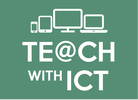Binary Representation of Characters
In this lesson, students will learn how characters are represented in a computer system.
Learning Objectives:
Lesson 1: Theory (Characters)
Suggested time: 50 mins
Starter:
Give students the attached worksheet (Starter.pdf) and ask them to complete the tasks.
Learning Objectives:
- Explain the use of binary codes to represent characters
- Explain the term character set
- Describe with examples (for example ASCII and Unicode) the relationship between the number of bits per character in a character set and the number of characters which can be represented
Lesson 1: Theory (Characters)
Suggested time: 50 mins
Starter:
Give students the attached worksheet (Starter.pdf) and ask them to complete the tasks.
| starter.pdf |
Main:
Explain that, in the previous lesson, the students have looked at how numbers are represented in a computer using binary. Also explain that characters are converted in the same way using something called a character set.
Inform students that one of the most commonly used character sets is ASCII (American Standard Code for Information Interchange) and show them the full 7-bit ascii table (See below).
Explain that, in the previous lesson, the students have looked at how numbers are represented in a computer using binary. Also explain that characters are converted in the same way using something called a character set.
Inform students that one of the most commonly used character sets is ASCII (American Standard Code for Information Interchange) and show them the full 7-bit ascii table (See below).
| 7-bit_ascii_table.pdf |
Explain that the ascii character set uses 7 bits which allows the computer to encode up to 128 characters.
Give students each a worksheet containing part of the ascii table (containing the letters A to Z in uppercase and lowercase) and ask the students to fill in the gaps in the table. Once complete, ask the students to attempt the challenges on the worksheet (see below).
Give students each a worksheet containing part of the ascii table (containing the letters A to Z in uppercase and lowercase) and ask the students to fill in the gaps in the table. Once complete, ask the students to attempt the challenges on the worksheet (see below).
| ascii_secret_agent_challenge.pdf |
| ascii_secret_agent_challenge_answers.pdf |
Resources:
Representation of text - http://web.eecs.utk.edu/research/cs100modules/module3/index.html
Ascii text to Binary converter - http://www.binaryhexconverter.com/ascii-text-to-binary-converter
Ascii Binary conversion chart - http://www.nthelp.com/ascii.htm
Text to Ascii and Binary converter - http://www.computingacademy.org.uk/text-ascii-and-binary-converter
Representation of text - http://web.eecs.utk.edu/research/cs100modules/module3/index.html
Ascii text to Binary converter - http://www.binaryhexconverter.com/ascii-text-to-binary-converter
Ascii Binary conversion chart - http://www.nthelp.com/ascii.htm
Text to Ascii and Binary converter - http://www.computingacademy.org.uk/text-ascii-and-binary-converter
Tags: GCSE, KS4, Theory, Computing Theory, CS Theory, Binary, Binary Representation, binary 2, binary conversion, how to do binary conversion, counting binary, binary number to decimal, binary 101, 8 binary, binary digits, binary digit, meaning of binary

